From The Soldier's Handbook, DA Pam 21-13, 1 June 1966
In order to be on effective soldier, a man must be in excellent physical condition. Physical training is primarily designed to get the man in condition and keep him in good physical condition. Experience has shown that few recruits enter the Army physically fit for strenuous duties of training. The softening influence of our modern machine civilization makes the problem of physically conditioning men more important than ever. Warfare makes great demands on a man's physical condition. He must be able to march long distances with full pack, weapons and ammunition through rugged country and to fight effectively upon arriving at the area of combat; to make assaults and to run and crawl for long distances; to jump into and out of foxholes, craters and trenches, to lift and carry heavy objects; to keep going for many hours without sleep or rest. Modern, mechanized warfare has not diminished the need for the soldier to be in "top notch" physical condition. There are always places where mechanized units cannot maneuver, tasks which they cannot accomplish, and situations in which equipment becomes disabled. Furthermore the machines are no better than the men operating them.
- Daily marches normally will be taken to and from your classes. During range firing, you may be required to march to and from the range complex. Usually during bivouac week you will be required to march 10 or more miles.
- The Physical Combat Proficiency Test will be administered to all personnel near the completion of basic training. Requirements for combat are demanding and can only be met by physically hardened soldiers.
- Each man will start with five repetition, of a set of callisthenic type exercises. You will progress until a minimum of twelve repetitions of each exercise have been achieved. Here are the exercises:
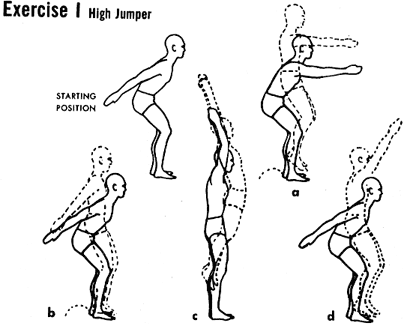
- Starting Position: Feet separated about 12 inches, knees slightly bent, body bent forward 45° at the waist, arms raised backward.
- Cadence: Moderate.
- Movement.
- Swing arms forward to shoulder height and jump upward a few inches.
- Swing arms backward and jump upward a few inches.
- Swing arms forward and overhead vigorously and jump upward at least 12 inches.
- Jump upward several inches and swing arms backward.
These movements of EXERCISE 1, the HIGH JUMPER are continuous and work into one another. The arm swing is much like that performed just prior to a standing broad jump. The jumps on counts a, b, and d, are merely "crow hops". The jump on count c calls for full effort.
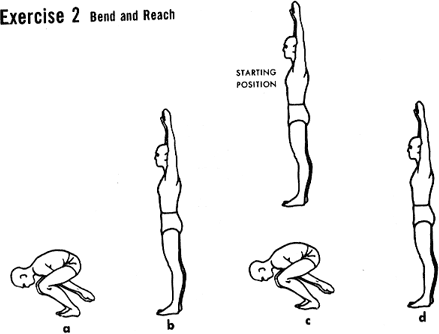
- Starting Position: Side straddle, arms overhead.
- Cadence: Moderate.
- Movement:
- Bend trunk forward and downward. At the same time swing arms between the legs, touching fingers to ground between and behind the heels. Knees are bent. Touch fingers as far behind heels as possible. Do not raise heels.
- Recover starting position.
- Repeat count a.
- Recover starting position.
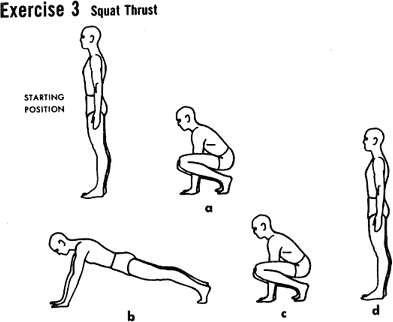
- Starting Position: Attention.
- Cadence: Moderate.
- Movement:
- Bend at knees and hips and, squatting down, place hands on the ground shoulder width apart. Keep elbows inside the knees.
- Thrust feet and legs backward to a front leaning rest position. Keep body straight from head to heels. Support weight on hands and toes.
- Recover to the squatting position.
- Recover to starting position.
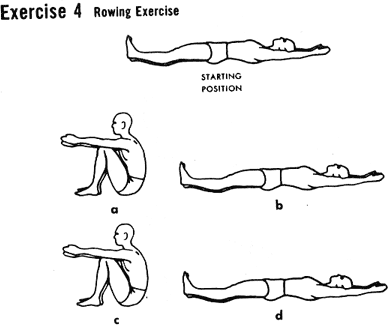
- Starting Position: On back, arms extended overhead, feet together.
- Cadence: Alternating Fast—Slow.
- Movement:
- Sit up sharply and at the same time bend knees sharply. Lean forward, swinging arms forward to a "rowing position." Keep knees together and against the chest, feet flat on the ground, and heels close to buttocks. Arms move forward and backward in a vertical plane.
- Recover slowly to starting position.
- Repeat count a.
- Recover slowly to starting position.
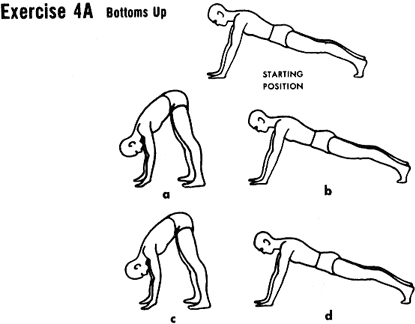
- Starting Position: Front leaning rest, body straight from head to heels, weight supported on hands and toes.
- Cadence: Moderate.
- Movement:
- Push against ground with feet, keeping knees straight, raise hips sharply and jump, feet forward so that hips are elevated and trunk and legs form an inverted V. Jump as far forward as possible with knees straight.
- Recover to starting position.
- Repeat count a.
- Recover to starting position.
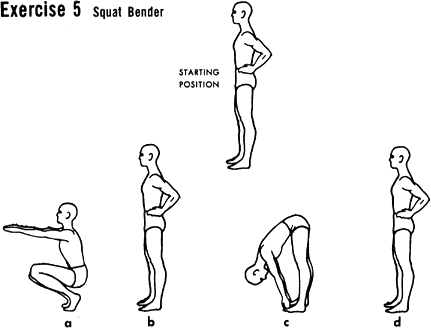
- Starting Position: Standing with feet slightly separated, hands on hips.
- Cadence: Moderate.
- Movement:
- Do a full knee bend, and thrust arms forward. Keep fingers extended, palms down and trunk erect.
- Recover to starting position.
- Bend trunk forward, keeping knees straight, touch ground in front of the toes.
- Recover to starting position.
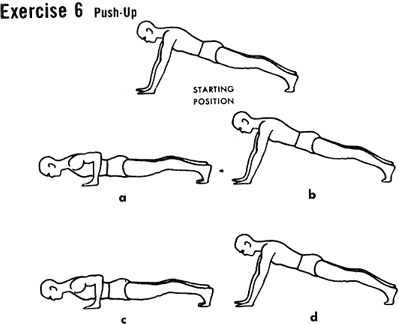
- Starting Position: Front leaning rest, body straight from head to heels, weight supported on hands and toes. Hands are directly under shoulders.
- Cadence: Moderate.
- Movement:
- Bend elbows and touch chest to ground keeping body straight.
- Straighten elbows, and recover to starting position.
- Repeat count a.
- Repeat count b.
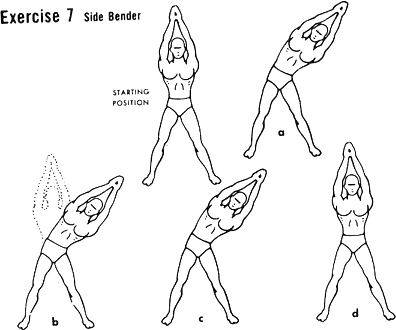
- Starting Position: Side straddle, arms overhead with upper arms forced against ears, thumbs interlocked.
- Cadence: Slow.
- Movement:
- Bend sidewards sharply to the left. Bend straight to the side without twisting the trunk or shoulders. Keep heels flat.
- Recover slightly and repeat with a bounce.
- Repeat count b.
- Recover to starting position.
Repeat on right side for counts e, f, and h.
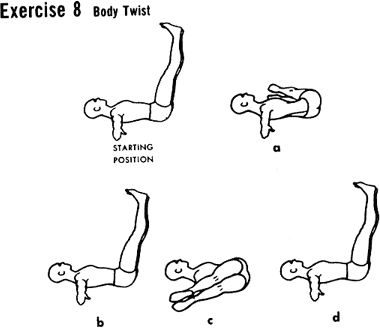
- Starting Position: On back, arms on ground and extended sideward, palms down, legs nearly vertical, feet together, knees locked.
- Cadence: Alternating Slow—Fast.
- Movement:
- Lower legs slowly to the left, twisting trunk and touching ground next to left hand. Keep knees straight, and both shoulders on ground. Legs must be lowered, not dropped.
- Recover sharply to starting position without bending knees.
- Lower legs slowly to right, twisting trunk, and touching ground near right hand.
- Recover sharply to starting position.
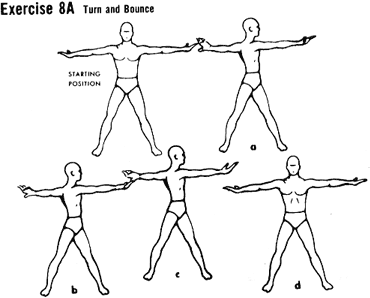
- Starting Position: Side straddle, arms sideward, palms up.
- Cadence: Slow.
- Movement:
- Turn trunk sharply to left to limit of motion, then relax rotation slightly.
- Bounce to the left, and relax slightly.
- Repeat count b.
- Recover to starting position.
Repeat on right side for counts e, f, g, and h.
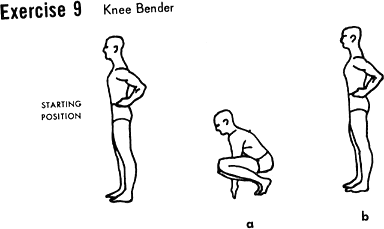
- Starting Position: Standing with feet slightly separated, hands on hips.
- Cadence: Moderate.
- Movement:
- Do a full knee bend, at the same time bend slightly forward at the waist and thrust the arms between the legs until the extended fingers touch the ground. The hands are about 6 inches apart.
- Recover sharply to the starting position.
- Repeat count a.
- Repeat count b.

- Starting Position: Side straddle, fingers laced behind head, elbows back, chin in.
- Cadence: Slow.
- Movement:
- Keeping knees locked, bend forward sharply, with a slight bouncing movement that causes slight recovery from the bend.
- Bounce downward, and simultaneously twist the trunk sharply to the left so that right elbow is down.
- Repeat count b to the right. This time the left elbow swings down.
- Recover to starting position.
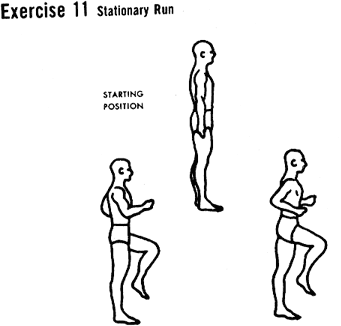
- Starting Position: Attention.
- Cadence: Fast.
- Movement: Begin run slowly, then speed up somewhat, raising knees above hips. Increase gradually to full speed, raising knees hard, then slow down. For men in good condition, this exercise should continue for approximately 1 to 1 1/2 minutes, the middle half minute of which should be at top speed. To start and stop the exercise the instructor counts two series of four, counting only as the left foot strikes the ground.
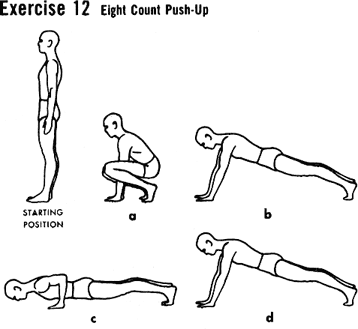
- Starting Position: Attention.
- Cadence: Moderate.
- Movement:
- Bend at knees and hips and place hands on floor in front of feet in squatting position.
- Thrust feet and legs backward to a front leaning rest position. Keep body straight from head to heels. Support weight on hands and toes.
- Bend elbows and touch chest to ground.
- Recover to front leaning rest position.
- Repeat count c.
- Recover to front leaning rest position.
- Recover to squatting position.
- Recover to starting position.
Комментариев нет:
Отправить комментарий